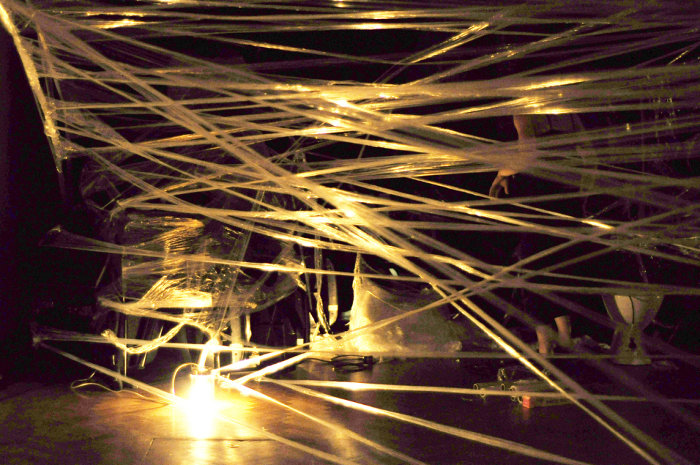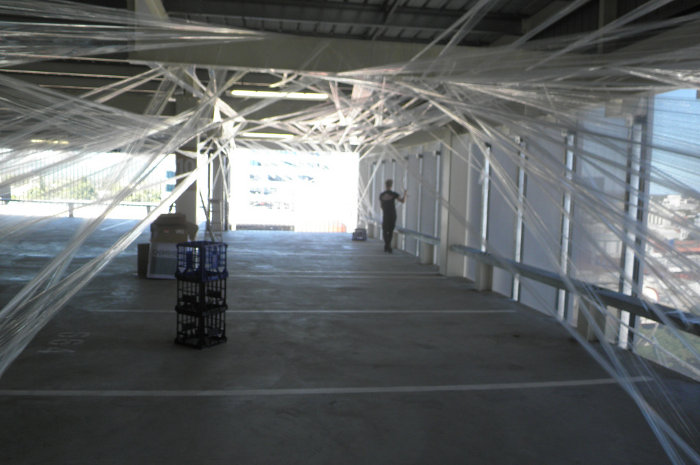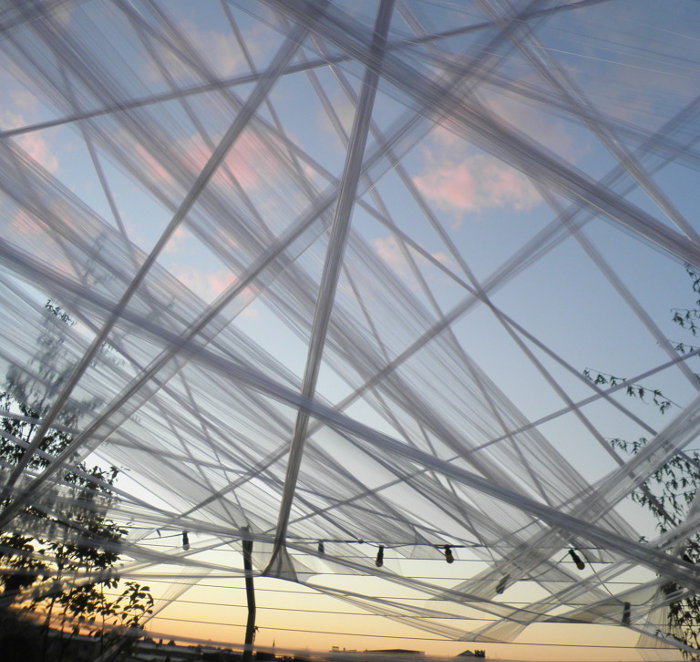In Mothlight the audience climb and edge through a space crossed by the strands of a luminous web. Two others inhabit this environment, one emerging from a suspended chrysalis, the other escaping from a tight plastic embrace. As they meet and interact, they move through a series of actions that seem at once to reveal and obscure the gestures and signs of human relationships. Below Skye Gellmann talks about the development of the work, and co-creator Naomi Francis joins for the scene's notes.
When the doors open and the audience enter there's just clingwrap in front of them. They have to climb through these little tunnels and as they come out the other end they're in a whole room of clingwrap with these small bulbs set in the clingwrap world kind of illuminating it. For about ten minutes they walk around and become familiar with the space.
We don't explain anything, and I think for Mothlight it works better with more confusion. For us the show will keep going even if the audience doesn't watch, and I think in a way that's why they watch: they want to know what they're doing there, what these two people are doing in this space, why there's no coherent thread. They're naturally inquisitive so they move towards us and follow us around the space to try and work out what's going on. It's a kind of beautiful confusion.
At the beginning of Mothlight Naomi and I started working together because we liked play fighting in the park. We had a good friendship, so we started working on ideas in the park and then in each other's houses. At the time I was interested in making some environments that people could interact with, that they could be inside of, but I can't remember exactly why we started using clingwrap. I just remember being in Naomi's room and we had clingwrap, and we pretty much wrapped her up sitting on a toilet bowl and there was a guitar wrapped to it as well, and then I started wrapping up her room and that's where it started – it's not like bedroom foreplay antics; we were just poor artists without a space, saying, All right we'll just make stuff in your room tonight.
It's actually a fitting place to work, because for me in a way the show is about relationships, and if there's one thing we wanted people to take away from Mothlight it's a feeling of an ambiguous relationship or an unusual relationship – one that you can't put your finger on as belonging to a particular type. And I think it's interesting creating in a bedroom, or in another person's living room, because it's just a very intimate space.
The most considered aspect of the piece is how Naomi and I treat each other and how that's read by the audience. We were looking at different ideas of intimacy – breaking down proximity, types of touch and eye contact. There's a relationship between the violence and the intimacy in the piece orbiting around a kind of sexuality without the fact. There are two moments in the show, the first at the end of this scene, where one of us touches the other all over. I think there's a lot that can be read into it. If I'm touching you all over in every area of your body that's a very sexual thing, but because we don't treat it as sex it takes on the ambiguous nature that we were interested in expressing in the relationship.
I think there's a lot of ambiguity in the violence as well because it happens without any reason. When Naomi climbs on my body and I'm wrapped in clingwrap it's very strenuous for me. It's painful, but for her it's also some kind of exploration; it's just her exploring space.
After working together for a few weeks we eventually got a rehearsal space and started creating different elements of the show and building different clingwrap structures. When we first started working together a lot of it was training. Naomi wasn’t from a circus background. She had skills in tight lining and was originally a rock climber and an engineer in the water sector, so her background was completely different from mine. I really like her presence in the space. It's very neutral; it portrays exactly the kind of presence I wanted in the show. Because I'm an acrobat I'm stiff and people can read that I'm an acrobat, but with Naomi she's completely natural.
We worked for a month and a half in the studio and then put the show on at Brisbane Festival's Under the Radar. We had these different performance elements, and we'd created the environment, but the opening night was the first time we'd had an audience come into the space. In Mothlight we actually make a huge web; you can't see it so well in the video but there's three or four thousand metres of clingwrap in the room. It's all around the audience and they have to climb through it to get to new areas of the performance.



Because the web is a world that the performance and the audience inhabit there's a tendency for people to expect that ours will be the kind of show that'll have a story or characters, or that it'll take place in like this mystical setting. But really I guess the web is the thing that lets us do what we want and forget about those things: we have this evocative but unexplainable environment, and that allows us to go against the idea of having to have a story or characters.
We found out what the show was about as we went. I guess we didn't worry about that too much at the beginning because we weren't completely sure what we'd created – which I think is actually a really good position to be in at the beginning.
The first time we performed Mothlight we didn't really know that the strength was in not having characters and not having story, or that by leaving those things out we created the quality of ambiguity that we were looking for. Over time our insecurity around rejecting these elements – and our insecurity about not doing anything in the space – went away, so we took more time in letting the piece unfold, and we weren't insecure about the fact that there was no story and there were no characters. I think we also refined the audience journey through the piece. In later seasons we began actually sculpting pathways through the audience in ways that created almost like this sculpture out of the people as they watched.
I guess essentially in Mothlight we're interested in not just the theatricality of what happens, but the theatricality of what goes on inside the audience. It starts with considering all the different elements of the show, like light and sound – and then asking what happens if you take away light, what happens if you take away sound? I'm interested in the audience's internal dialogue – the way that they think during the show. I want their thought processes to be highly engaged, and sometimes a way to get people thinking and start them building their own story is to just turn off the lights. Either they get really involved in imagining what's happening, or they disengage and then when you turn the lights back on they re-engage – and maybe they notice they did that, or maybe they don't.
I'm interested in ideas of reality and the way that we engage with space and environment – and how a landscape becomes an environment when you use it or when you interact with it. A personal part of my practice is also that I'm always going through existential crises – like I don't know what is going on, and turning on the lights and turning them off again is like going, Is this real? Am I really in front of you, is this really my life? If this is my life I'm really in a strange situation standing in front of all these people. So I guess my own thought process is engaged in this way which is like testing to see if it's real, and I'm hoping that'll bring other people to a sharper sense of what's going on around them.
Going further back I think it comes from the feeling of being objectified as a circus performer. And that happened because I did a lot of corporate circus work – like being a mascot at the Tennis Open or whatever. That stuff drove me mad and made me want people to start being aware that they were witnessing something – that they were actually present, that they had a force in the space, that the circus performance was more than a spectacle and they were a part of it, and I think in Mothlight people watch each other and see that they're part of that landscape. Their role might only be to watch, or to be a spectator or an explorer, but they're part of that theatrical landscape.
The extract presented here is from a performance given at the Judith Wright Centre of Contemporary Arts' Shopfront space, in Brisbane, where the piece ran 2-4 February 2011.
Skye Gellmann is currently touring Blindscape, an immersive work combining improvised performance and game design that sees the audience navigate a darkened space and surreal soundscape using iPhones. Naomi Francis is currently performing in Ether, a physical theatre piece about the bonds between twins, made with Devon Taylor and presented by Murmur Collective.
Skye Gellmann was interviewed by John Ellingsworth over Skype 3 October 2013, and Naomi Francis over Skype 10 October 2013.
This interview was produced as part of the project Deconstructing Circus with the support of Arts Council England.